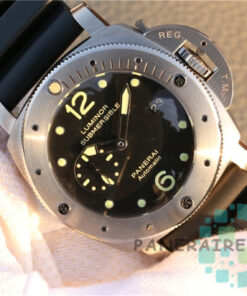|
The incredible story of the Panerai diving watch almost lost to the sea The sea is an appropriate metaphor, as the ur oversize timepiece started life sculling beneath Mediterranean waves, as anything but a statement timepiece. Long before the likes of Audemars Piguet's Royal Oak Offshore swaggered onto the scene 30 years ago, Florentine engineering firm Officine Panerai was, in 1935, answering a request from the Royal Italian Navy: to create a waterproof watch for its covert frogmen, to keep them synchronised while sneaking up to enemy ships' hulls and attaching limpet mines. It worked a bit too well in fact - upon crossing enemy lines, aboard their two-man ‘torpedo' mini-subs, the ‘incursori' combat swimmers would have to cover their wrists with cloth to obscure the glow of their Radiomir watches: adapted from existing, cushion-shaped Rolex ‘Oyster' pocket watches, with stencilled-out ‘sandwich' dials retro-fitted atop fully luminescent base dials. All of which was totally unbeknownst until the nineties, when the Italian military secrets act expired and Panerai was revealed to be the watchmaker every alpha male should covet. Well, eventually... A few years before being snatched from obscurity by the Richemont Group and given its own purpose-built Swiss manufacturing facilities, Panerai was on the ropes. If it wasn't for a Japanese watch magazine running a nostalgic cover story in 1992, new owner Dino Zei might never have been inspired to tentatively commercialise a strangely shaped diving watch discontinued in the seventies. That watch was Signore Panerai's ‘Luminor' from two decades before, now with less-lethal tritium providing the glow, and fitted with a D-shaped crown guard. Zei ordered a run of 1,000, made in Switzerland. If it wasn't for that tiny run, a well-connected Montenegrin photographer called Monty Shadow (bear with us, here) might then have never spotted one of those reissues in a Milanese shop window, then been so bold as to doorstep Panerai with the promise of brokering some white-hot product placement on the wrists of two Hollywood friends in their respective summer-of-'96 blockbusters, Daylight and Eraser. Arnie, Sly Stallone, Hugh Grant, Dwayne ‘The Rock' Johnson, Jason Statham... |
 |
